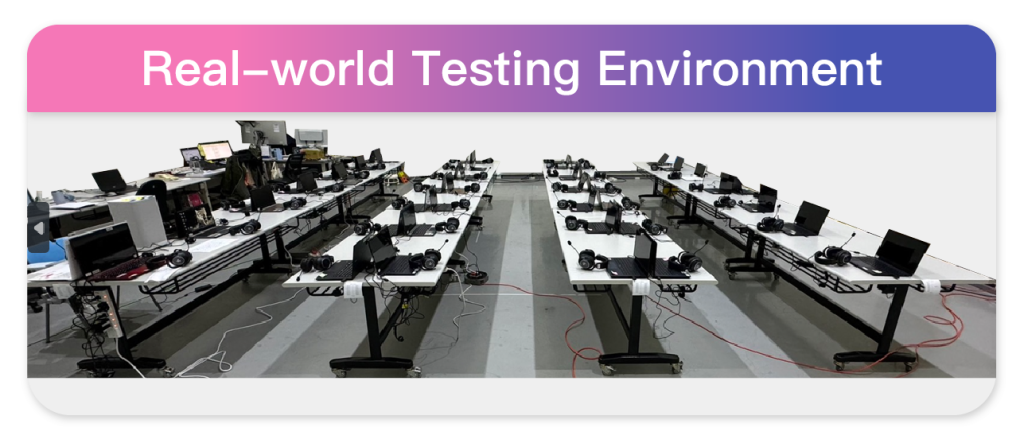Application Environment and Customer Needs
Bluetooth devices are becoming increasingly popular, but are you aware of the risks hidden in high-density usage environments? Users often face interference issues when using Bluetooth accessories such as keyboards, mice, and headsets. This is primarily because the 2.4GHz frequency band used by Bluetooth devices overlaps with many other wireless devices (such as Wi-Fi, Thread, etc.), leading to frequency congestion and increasing the likelihood of interference.
Common Interference Scenarios
- Customer Service Centers: Customer service centers typically have many workstations, each possibly equipped with Bluetooth keyboards, mice, and headsets. Since these devices all use the 2.4GHz frequency band, congestion within the center’s frequency range increases the chances of signal interference. Additionally, multiple wireless network devices and other electronic equipment inside the center can further affect the performance of Bluetooth devices.
- Office Environments: In offices, particularly open-plan spaces, Bluetooth devices may also encounter interference. Many employees use Bluetooth keyboards, mice, and headsets simultaneously, and the presence of wireless network devices further congests the wireless signals. In this environment, Bluetooth devices are more prone to interference, which can impact their performance.
- Internet Cafes: In internet cafes, many computers and gaming devices operate simultaneously, with many of them using the 2.4GHz band for wireless connections. This high-density equipment layout leads to frequency congestion and signal interference, affecting the stability and performance of Bluetooth accessories.
- Public Spaces (e.g., shopping malls, airports, metro stations): In public spaces where many public and commercial devices share the 2.4GHz band, Bluetooth interference becomes a significant issue. Electronic signage in malls, boarding pass systems in airports, and ticketing systems in metro stations can all impact Bluetooth devices.
Specific Manifestations of Interference Issues
- Bluetooth Keyboards: In high-interference environments, Bluetooth keyboards may experience slow key response, typing delays, or typographical errors. This occurs because the Bluetooth signal is interfered with, causing the keyboard’s input data to fail to transmit quickly and accurately to the computer.
- Bluetooth Mice: Interference can affect the movement accuracy of a mouse, causing the cursor to move in a jerky, erratic, or drifting manner. In such cases, users may notice that the mouse’s response becomes unstable, affecting the smoothness and accuracy of operations.
- Bluetooth Headsets: When Bluetooth headsets are affected by interference, users may experience audio issues such as static, noise, or intermittent sound. This negatively impacts call quality or music listening experiences, further affecting users’ work and entertainment.
In conclusion, interference with Bluetooth accessories is particularly noticeable in high-density environments. Ensuring that products have strong anti-interference capabilities and enhancing their performance to provide a stable user experience and high productivity in busy work and entertainment settings is a major challenge for Bluetooth product manufacturers. As Bluetooth devices become more common in environments such as customer service centers, internet cafes, and large offices, performance issues are increasingly evident. These issues affect user experience and brand reputation, which can ultimately weaken market competitiveness.

Customer’s Problems and Challenges
Here is a real customer case study. A long-term client, an internationally renowned computer accessories manufacturer, previously launched Bluetooth headphones that encountered intermittent connection dropouts and degraded sound quality in customer service center environments. This not only affected the product’s reputation but also led to numerous customer complaints and increased costs for subsequent updates and maintenance. To avoid a recurrence of these issues, they sought solutions and recommendations from Allion for their new product development.
Key Problems and Challenges Faced by the Client
- Technical Challenges:
- How to maintain a stable connection in high-density, high-interference environments.
- How to optimize channel selection algorithms and antenna designs.
- How to improve anti-interference capabilities.
- Testing and Validation Challenges:
- Lack of capability to simulate complex usage scenarios.
- Internal limitations in conducting comprehensive and systematic performance testing.
- Market Challenges:
- The need to meet high-performance requirements across various environments.
- How to maintain a competitive edge in a highly competitive market.
Solution
The interference issues with Bluetooth devices in high-density environments can be complex and challenging. Allion provides a one-stop solution that offers comprehensive testing and optimization for Bluetooth devices such as keyboards, mice, and headphones, ensuring optimal performance in high-density environments.
Allion’s One-Stop Solution
Realistic Simulation Testing Environment
Allion set up a realistic testing environment to simulate various high-density usage scenarios:
- Simulating Multiple Workstations: Recreating a high-density user application scenario to test the performance of various Bluetooth devices (including keyboards, mice, and headphones) in real-world conditions.
- Recreating High-Density Wi-Fi Networks: Simulating interference from Wi-Fi networks and other wireless devices to assess the Bluetooth devices’ anti-interference capabilities in such environments.

Comprehensive Performance Testing
We conducted a series of rigorous tests for Bluetooth keyboards, mice, and headphones:
- Performance Tests:
- Bluetooth Keyboards: Evaluated input latency, sensitivity, response delay, and tested connection stability in crowded wireless environments.
- Bluetooth Mice: Tested input lag, sensitivity, response delay, and analyzed polling rate performance in a coexisting wireless environment.
- Bluetooth Headphones: Assessed sound quality, audio latency, crackling, and audio glitches.
- Multi-User Stress Testing:
- Gradually increased the number of active Bluetooth devices and analyzed performance changes in keyboards, mice, and headphones, testing stability in high-density device environments.
- Interference Resistance Evaluation:
- Introduced various 2.4GHz devices to test Bluetooth devices’ resistance to interference, ensuring reliable connections in busy wireless environments.
In-Depth Problem Analysis and Customized Solutions
Through detailed analysis, we helped the customer identify potential issues with different Bluetooth devices in high-density environments:
- Bluetooth Keyboards: Auto-reconnection issues, excessive input delay, and reduced sensitivity.
- Bluetooth Mice: Jerky movement, insufficient polling rate, and unstable response delays.
- Bluetooth Headphones: Inefficient channel selection algorithms, sound interference, and audio glitches.
Based on these findings, we provided the following improvement recommendations:
-
- Optimize Channel Selection Algorithms: Improve adaptability in crowded environments to reduce interference.
- Redesign Antennas: Enhance antenna design to improve omnidirectional signal reception and reduce signal attenuation.
- Upgrade Bluetooth Chipsets: Implement more advanced anti-interference technology to improve connection stability and resistance to interference.
For example, during the actual testing of Bluetooth headphones, we gradually increased the number of Bluetooth devices. The results showed that when the number of devices exceeded 40, the headphones began to experience audio crackling. When the number was increased to over 60 devices, the sound quality significantly decreased, greatly affecting the user’s music experience. Based on these test results, we provided targeted improvement recommendations, significantly enhancing the connection stability and sound quality of the headphones in high-density environments.

Allion’s solutions helped this accessories manufacturer effectively resolve high-density wireless interference issues, improve product quality, and earn consumer trust.
Creating Value
Time to Market with Quality!
Faster! Easier! Better!
Faster
- Advanced Simulation Testing Environment:
-
- Rapid Setup of Test Environments: Allion is capable of quickly setting up testing environments that simulate high-density usage scenarios such as large open office spaces, internet cafés, and public venues. These environments can simulate hundreds of workstations using various Bluetooth devices and quickly provide real-world test data.
- Efficient Testing Processes: Our comprehensive performance testing and multi-user stress testing can quickly uncover Bluetooth device performance issues under different density and interference conditions, saving product development time and reducing time-to-market.
- Rapid Problem Analysis and Recommendations:
-
- Instant Problem Detection and Analysis: With precise testing instruments and professional analysis methods, Allion can quickly identify issues in Bluetooth devices and provide immediate improvement recommendations.
- Efficient Improvement Recommendations: Our professional team can quickly implement corrective measures, ensuring that products undergo necessary adjustments and optimizations in a short period.
Easier
- One-Stop Solution:
-
- Comprehensive Services: Allion provides a one-stop service ranging from product specification consulting, hardware design, anti-interference testing, to post-market quality assurance, simplifying the customer’s workflow and eliminating the need for multiple solutions.
- Tailored Testing Solutions: We offer customized testing and improvement plans based on the characteristics of different Bluetooth devices (keyboards, mice, and headphones), ensuring that each product receives the most suitable treatment.
- Professional Equipment and Environmental Planning:
-
- Simplified Test Setup: Allion designs diverse testing sites and uses professional environments to simulate congestion in different frequency bands, providing easy-to-use testing solutions for customers.
Better
- High-Quality Testing and Analysis:
-
- In-Depth Performance Testing: Performance tests, multi-user stress tests, and anti-interference assessments comprehensively evaluate Bluetooth devices in various environments, ensuring high product quality.
- Professional Problem Analysis and Recommendations: Through in-depth performance analysis of Bluetooth devices, we provide specific improvement recommendations to enhance device stability and user experience in high-density environments.
- Rich Industry Experience:
-
- Industry-Leading Professional Team: Allion has extensive experience in Bluetooth product testing, and our professional team can provide relevant technical support and consulting, helping manufacturers enhance product quality and ensure market success.
- Significant Performance Improvement: This collaboration case shows that through our improvements, the Bluetooth headset’s connection stability in high-density environments was enhanced by 40%, significantly improving user satisfaction.
In summary, Allion provides faster testing speeds, simpler solutions, and better product performance enhancements in Bluetooth device testing and improvement. These advantages help our clients maintain a competitive edge in a fast-paced market and ensure their products perform excellently in various usage environments.

If you are looking for a reliable accessory product testing and problem-solving consultant, feel free to contact Allion.






































